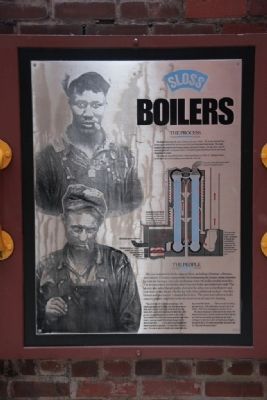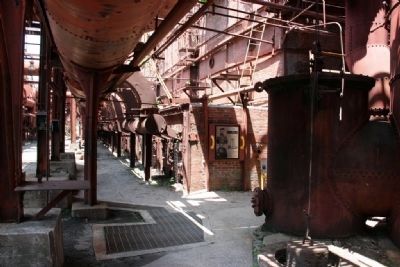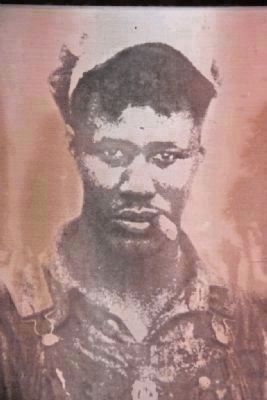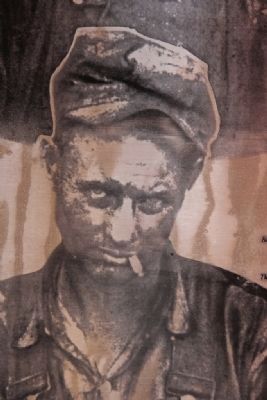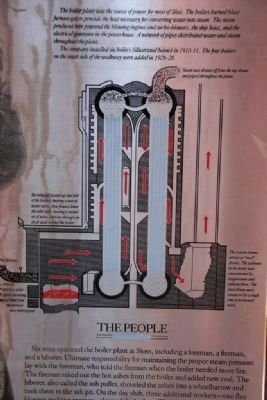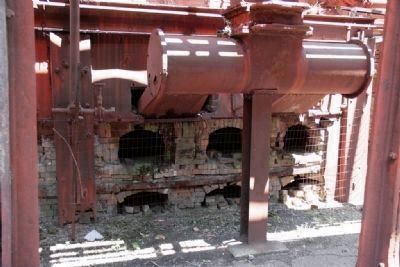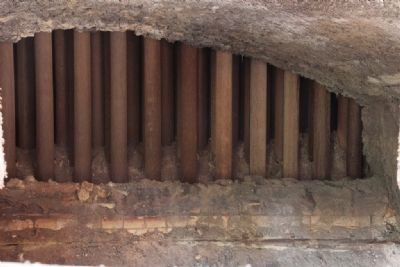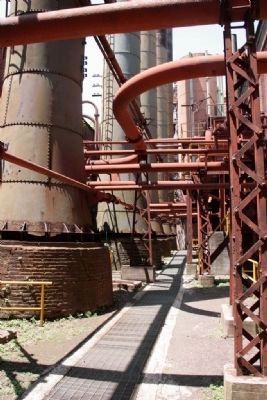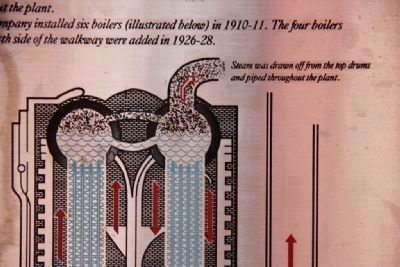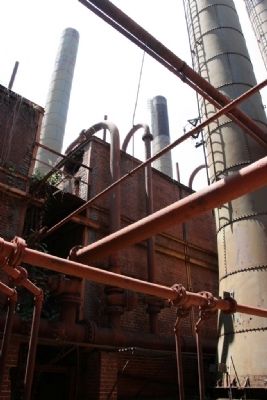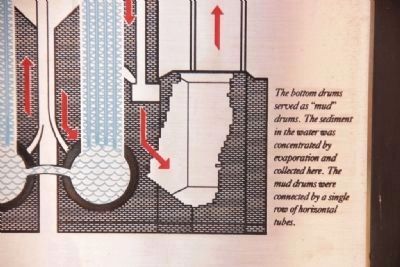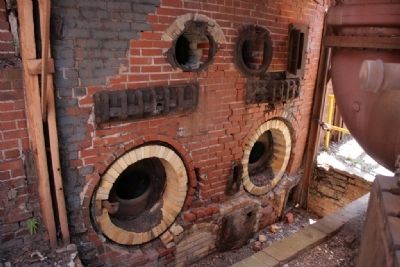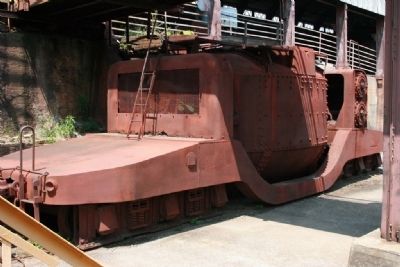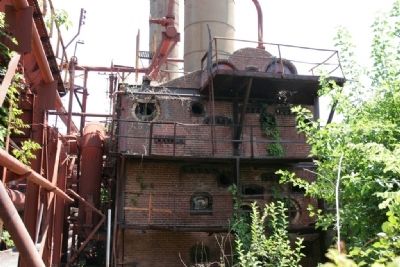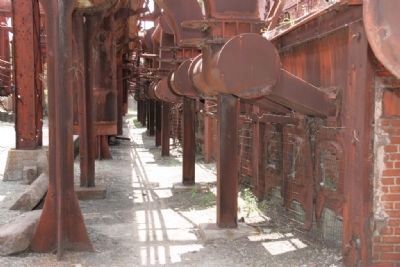Birmingham in Jefferson County, Alabama — The American South (East South Central)
Boilers
Sloss Furnaces National Historic Landmark
The Process
The boiler was the source of power for most of Sloss. The boilers burned blast furnace gas to provide the heat necessary for converting water into steam. The steam produced here powered the blowing engines and turbo-blowers, the skip hoist, and the electrical generator in the powerhouse. A network of pipes distributed water and steam throughout the plant
The company installed six boilers (illustrated below) in 1910-11. The four boilers on the south side of the walkway were added in 1926-28.
The People
Six men operated the boiler plant at Sloss, including a foreman, a fireman, and a laborer. Ultimate responsibility for maintaining the proper steam pressure lay with the foreman, who told the fireman when the boiler needed more fire. The fireman raked out the hot ashes from the boiler and added new coal. The laborer, also called the ash puller, shoveled the ashes into a wheelbarrow and took them to the ash pit. On the day shift, three additional workers—two flue blowers and one reamer—cleaned the boilers. The plant had sufficient boiler capacity to allow one boiler to be out of service at all times for cleaning.
"You never ran the boilers on straight gas. You always put some coal in them. I've had one or two or three shifts where I didn't put in but one fire for the whole shift, and I didn't put much in there then. The gas was just good enough to run them at that time. I had so many more shifts that the gas wouldn't run them boilers, and you couldn't hardly get enough coal in there to run them....I have seen the superintendent shovel coal when it got tight. I've seen him, the stoveman, I've seen as much as twelve men down there trying to hold that steam....There are only two things out there to do. If the steam fall, you put coal in the boilers. And if you running good, you just run on...
We always would go in there and do our work. We knowed what to do, and the quicker we'd do it the better break we were going to get when we got it did... As long as it take you to do it, if it take you all night, you had to do it. If it took you one hour, you had to do it, That's just the way it was."
Erected by Sloss Furnaces National Historic Landmark.
Topics. This historical marker is listed in this topic list: Industry & Commerce.
Location. 33° 31.224′ N, 86° 47.478′ W. Marker is in Birmingham, Alabama, in Jefferson County. Marker can be reached from the intersection of 32nd Street North and 2nd Avenue North. Marker is located on the grounds of Sloss Furnaces National Historic Landmark. Touch for map. Marker is at or near this postal address: Twenty 32nd Street North, Birmingham AL 35222, United States of America. Touch for directions.
Other nearby markers. At least 8 other markers are within walking distance of this marker. The Gas System (within shouting distance of this marker); Slag (within shouting distance of this marker); The Blowing Engine Room (within shouting distance of this marker); Stock Trestle/Tunnel (within shouting distance of this marker); Ironmaking (within shouting distance of this marker); The Blast Furnace (within shouting distance of this marker); Casting Pigs (within shouting distance of this marker); The Stock Trestle (within shouting distance of this marker). Touch for a list and map of all markers in Birmingham.
Also see . . . Sloss Furnaces National Historic Landmark website. (Submitted on June 24, 2011, by Timothy Carr of Birmingham, Alabama.)
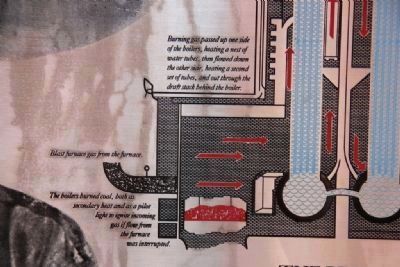
Photographed By Tim & Renda Carr, June 12, 2011
8. Operation diagram of the boilers.
(1) Blast furnace gas from the furnace.
(2) The boiler burned coal, both as secondary heat and as a pilot light to ignite incoming gas if flow from the furnace was interrupted.
(3) Burning gas passed up one side of the boilers, heating a nest of water tubes, then flowed down the other side, heating a second set of tubes, and out through the draft stack behind the boiler.
(2) The boiler burned coal, both as secondary heat and as a pilot light to ignite incoming gas if flow from the furnace was interrupted.
(3) Burning gas passed up one side of the boilers, heating a nest of water tubes, then flowed down the other side, heating a second set of tubes, and out through the draft stack behind the boiler.
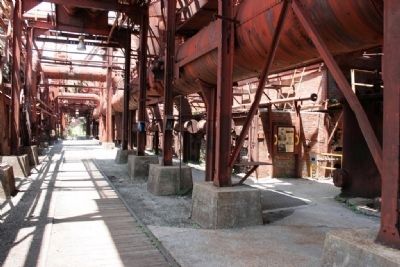
Photographed By Tim & Renda Carr, June 24, 2011
16. Delivery Track along Boiler Row.
Delivery tracks used to deliver coal to the boilers, and the ladle car traverse between the two furnaces receiving the hot molten iron. Once the ladle was filled then the ladle car was moved to the pig casting machine on the other end of the plant. There the hot molten iron is poured into pigs.
Credits. This page was last revised on June 16, 2016. It was originally submitted on June 24, 2011, by Timothy Carr of Birmingham, Alabama. This page has been viewed 1,295 times since then and 21 times this year. Photos: 1, 2, 3, 4, 5, 6, 7, 8, 9, 10, 11, 12, 13, 14, 15, 16, 17, 18, 19. submitted on June 24, 2011, by Timothy Carr of Birmingham, Alabama. • Bernard Fisher was the editor who published this page.
